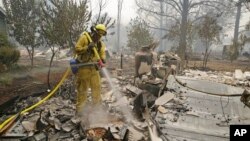A wildfire that raced through dry brush in Northern California on Sunday heavily damaged the small town of Middletown, burning buildings in the downtown and reducing other parts of the town to ash.
The blaze in Lake County is one of two wildfires that sped through parched Northern California on Sunday, destroying at least 81 homes, forcing thousands to flee, injuring four firefighters and prompting the governor to declare a state of emergency.
Residents streamed from Middletown Sunday morning and had to dodge smoldering telephone poles, downed power lines and fallen trees as they drove through billowing smoke.
George Escalona told The Associated Press that parts of his town, including his home, have burned to the ground.
In some areas of town "there is nothing but burned houses, burned cars,'' Escalana said, adding that he had nothing left but the clothes he was wearing.
The 60-square-mile (155-square-kilometer) fire in Lake County erupted Saturday afternoon and rapidly chewed through brush and trees parched from several years of drought, the California Department of Forestry and Fire Protection said. Entire towns as well as residents along a 35-mile (56-kilometer) stretch of highway were evacuated. Gov. Jerry Brown on Sunday declared a state of emergency to free up resources.
The four firefighters who were injured were all members of a helicopter crew. They were airlifted to a hospital burn unit, where they were being treated for second-degree burns and were listed in stable condition, department spokesman Daniel Berlant said.
Brown had already declared a state of emergency for a separate 101-square-mile (262-square-kilometer) wildfire about 70 miles (113 kilometers) southeast of Sacramento that has destroyed at least 81 homes and 51 outbuildings and turned the grassy, tree-studded Sierra Nevada foothills an eerie white. Fire officials had earlier counted 86 homes destroyed, but issued the new figure Sunday morning.
Crews by Sunday morning had increased containment on that blaze to 20 percent.
The fire, which broke out on Wednesday was threatening about 6,400 more buildings.
"I lost my business. It's all burned up - my shop, my house, 28 years of living,'' said Joe Thomas, who lives near the community of Mountain Ranch. "I got to start all over. It's depressing.''
Thomas, who runs a tractor dealership and repair business, said he and his wife grabbed papers, his work computer, photos and their four dogs. But they left a goat, five ducks, six rabbits and more than 30 chickens behind.
"I turned the pens open and turned them lose. I just couldn't gather them up,'' he said. "All we want to do is go home. It's miserable.''
Meanwhile, new evacuation orders were issued Saturday for the largest wildfire in the state, threatening to sweep through an ancient grove of Giant Sequoia trees. The fire, sparked by lightning on July 31, has charred 201 square miles (521 square kilometers), the U.S. Forest Service said.
Firefighters cleared brush around the Grant Grove and set prescribed burns to keep the flames from overrunning it. By Saturday, the backfiring and monitoring efforts appeared to have helped protect the treasured trees, the Fresno Bee reported.
The grove is named for the towering General Grant tree that stands 268 feet (82 meters) tall. There are dozens of Sequoia groves in the Sierra Nevada, and some trees are 3,000 years old.







